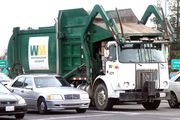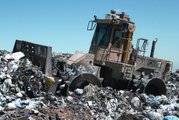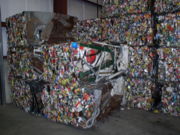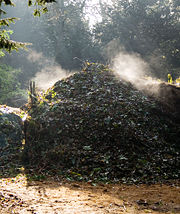Waste management
2008/9 Schools Wikipedia Selection. Related subjects: Environment

Waste management is the collection, transport, processing, recycling or disposal of waste materials. The term usually relates to materials produced by human activity, and is generally undertaken to reduce their effect on health, the environment or aesthetics. Waste management is also carried out to recover resources from it. Waste management can involve solid, liquid, gaseous or radioactive substances, with different methods and fields of expertise for each.
Waste management practices differ for developed and developing nations, for urban and rural areas, and for residential and industrial, producers. Management for non- hazardous residential and institutional waste in metropolitan areas is usually the responsibility of local government authorities, while management for non-hazardous commercial and industrial waste is usually the responsibility of the generator.
Waste management methods
Waste management methods vary widely between areas for many reasons, including type of waste material, nearby land uses, and the area available.
Disposal methods
Landfill
Disposing of waste in a landfill involves burying waste to dispose of it, and this remains a common practice in most countries. Landfills were often established in disused quarries, mining voids or borrow pits. A properly-designed and well-managed landfill can be a hygienic and relatively inexpensive method of disposing of waste materials. Older, poorly-designed or poorly-managed landfills can create a number of adverse environmental impacts such as wind-blown litter, attraction of vermin, and generation of liquid leachate. Another common byproduct of landfills is gas (mostly composed of methane and carbon dioxide), which is produced as organic waste breaks down anaerobically. This gas can create odour problems, kill surface vegetation, and is a greenhouse gas.
Design characteristics of a modern landfill include methods to contain leachate such as clay or plastic lining material. Deposited waste is normally compacted to increase its density and stability, and covered to prevent attracting vermin (such as mice or rats). Many landfills also have landfill gas extraction systems installed to extract the landfill gas. Gas is pumped out of the landfill using perforated pipes and flared off or burnt in a gas engine to generate electricity.
Incineration

Incineration is a disposal method that involves combustion of waste material. Incineration and other high temperature waste treatment systems are sometimes described as " thermal treatment". Incinerators convert waste materials into heat, gas, steam, and ash.
Incineration is carried out both on a small scale by individuals, and on a large scale by industry. It is used to dispose of solid, liquid and gaseous waste. It is recognized as a practical method of disposing of certain hazardous waste materials (such as biological medical waste). Incineration is a controversial method of waste disposal, due to issues such as emission of gaseous pollutants.
Incineration is common in countries such as Japan where land is more scarce, as these facilities generally do not require as much area as landfills. Waste-to-energy (WtE) or energy-from-waste (EfW) are broad terms for facilities that burn waste in a furnace or boiler to generate heat, steam and/or electricity. Combustion in an incinerator is not always perfect and there have been concerns about micro-pollutants in gaseous emissions from incinerator stacks. Particular concern has focussed on some very persistent organics such as Dioxins which may be created within the incinerator and which may have serious environmental consequences in the area immediately around the incinerator.
Recycling methods
The process of extracting resources or value from waste is generally referred to as recycling, meaning to recover or reuse the material. There are a number of different methods by which waste material is recycled: the raw materials may be extracted and reprocessed, or the calorific content of the waste may be converted to electricity. New methods of recycling are being developed continuously, and are described briefly below.
Physical reprocessing
The popular meaning of ‘recycling’ in most developed countries refers to the widespread collection and reuse of everyday waste materials such as empty beverage containers. These are collected and sorted into common types so that the raw materials from which the items are made can be reprocessed into new products. Material for recycling may be collected separately from general waste using dedicated bins and collection vehicles, or sorted directly from mixed waste streams.
The most common consumer products recycled include aluminium beverage cans, steel food and aerosol cans, HDPE and PET bottles, glass bottles and jars, paperboard cartons, newspapers, magazines, and cardboard. Other types of plastic ( PVC, LDPE, PP, and PS: see resin identification code) are also recyclable, although these are not as commonly collected. These items are usually composed of a single type of material, making them relatively easy to recycle into new products. The recycling of complex products (such as computers and electronic equipment) is more difficult, due to the additional dismantling and separation required.
Biological reprocessing
Waste materials that are organic in nature, such as plant material, food scraps, and paper products, can be recycled using biological composting and digestion processes to decompose the organic matter. The resulting organic material is then recycled as mulch or compost for agricultural or landscaping purposes. In addition, waste gas from the process (such as methane) can be captured and used for generating electricity. The intention of biological processing in waste management is to control and accelerate the natural process of decomposition of organic matter.
There are a large variety of composting and digestion methods and technologies varying in complexity from simple home compost heaps, to industrial-scale enclosed-vessel digestion of mixed domestic waste (see Mechanical biological treatment). Methods of biological decomposition are differentiated as being aerobic or anaerobic methods, though hybrids of the two methods also exist.
An example of waste management through composting is the Green Bin Program in Toronto, Canada, where household organic waste (such as kitchen scraps and plant cuttings) are collected in a dedicated container and then composted.
Energy recovery

The energy content of waste products can be harnessed directly by using them as a direct combustion fuel, or indirectly by processing them into another type of fuel. Recycling through thermal treatment ranges from using waste as a fuel source for cooking or heating, to fuel for boilers to generate steam and electricity in a turbine. Pyrolysis and gasification are two related forms of thermal treatment where waste materials are heated to high temperatures with limited oxygen availability. The process typically occurs in a sealed vessel under high pressure. Pyrolysis of solid waste converts the material into solid, liquid and gas products. The liquid and gas can be burnt to produce energy or refined into other products. The solid residue (char) can be further refined into products such as activated carbon. Gasification and advanced Plasma arc gasification are used to convert organic materials directly into a synthetic gas ( syngas) composed of carbon monoxide and hydrogen. The gas is then burnt to produce electricity and steam.
Avoidance and reduction methods
An important method of waste management is the prevention of waste material being created, also known as waste reduction. Methods of avoidance include reuse of second-hand products, repairing broken items instead of buying new, designing products to be refillable or reusable (such as cotton instead of plastic shopping bags), encouraging consumers to avoid using disposable products (such as disposable cutlery), and designing products that use less material to achieve the same purpose (for example, lightweighting of beverage cans).
Waste handling and transport

Waste collection methods vary widely between different countries and regions. Domestic waste collection services are often provided by local government authorities, or by private industry. Some areas, especially those in less developed countries, do not have a formal waste-collection system. Examples of waste handling systems include:
- In Australia, most urban domestic households have a 240-litre (63.4 U.S. gallon) bin that is emptied weekly from the curb using side- or rear-loading compactor trucks.
- In Europe and a few other places around the world, a few communities use a proprietary collection system known as Envac, which conveys refuse via underground conduits using a vacuum system.
- In Canadian urban centres curbside collection is the most common method of disposal, whereby the city collects waste and/or recyclables and/or organics on a scheduled basis. In rural areas people often dispose of their waste by hauling it to a transfer station. Waste collected is then transported to a regional landfill.
- In Taipei the city government charges its households and industries for the volume of rubbish they produce. Waste will only be collected by the city council if waste is desposed in government issued rubbish bags. This policy has successfully reduced the amount of waste the city produces and increased the recycling rate.
Waste management concepts
There are a number of concepts about waste management which vary in their usage between countries or regions. Some of the most general, widely-used concepts include:
- Waste hierarchy - the waste hierarchy refers to the "3 Rs" reduce, reuse and recycle, which classify waste management strategies according to their desirability in terms of waste minimization. The waste hierarchy remains the cornerstone of most waste minimization strategies. The aim of the waste hierarchy is to extract the maximum practical benefits from products and to generate the minimum amount of waste.
- Extended producer responsibility - Extended Producer Responsibility (EPR) is a strategy designed to promote the integration of all costs associated with products throughout their life cycle (including end-of-life disposal costs) into the market price of the product. Extended producer responsibility is meant to impose accountability over the entire lifecycle of products and packaging introduced to the market. This means that firms which manufacture, import and/or sell products are required to be responsible for the products after their useful life as well as during manufacture.
- Polluter pays principle - the Polluter Pays Principle is a principle where the polluting party pays for the impact caused to the environment. With respect to waste management, this generally refers to the requirement for a waste generator to pay for appropriate disposal of the waste.




